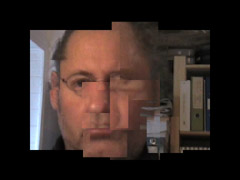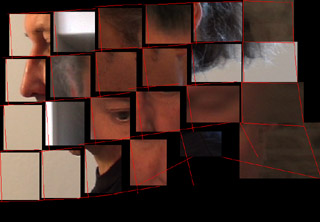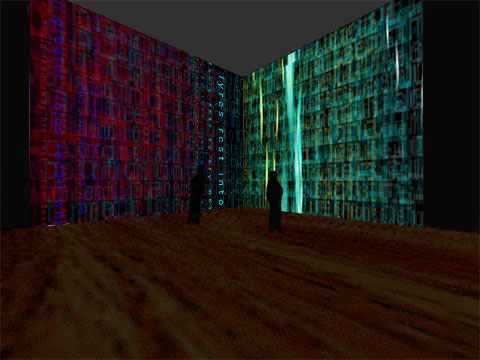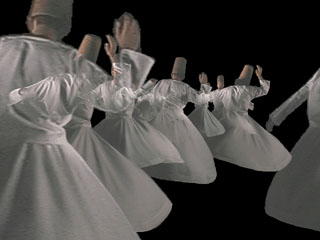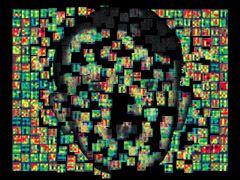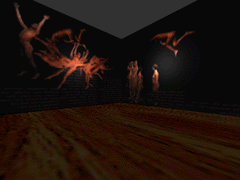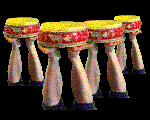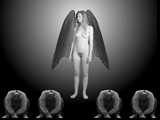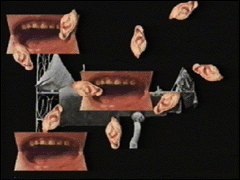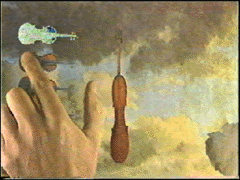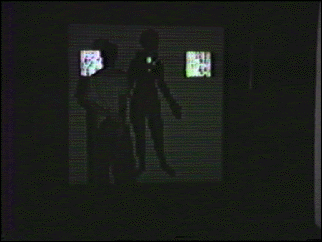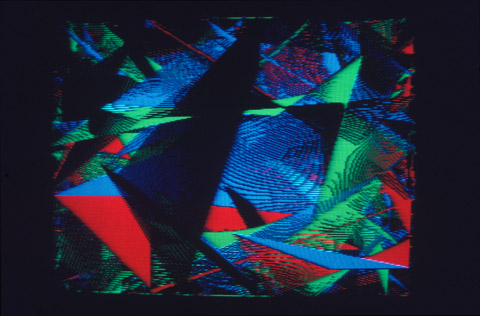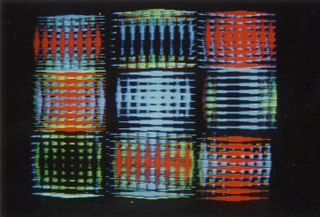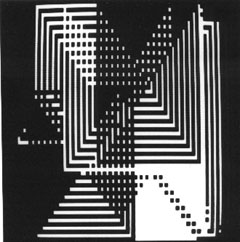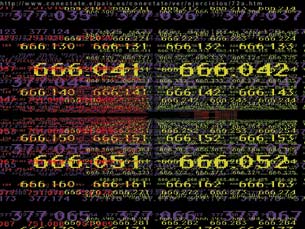Biggs Simon
Personaggio
Simon Biggs è un artista australiano, da anni si occupa di studiare la tematica dell’identità e quella della realtà intesa come costrutto sociale.
Biografia
Nasce nel 1957 ad Adelaide, nel sud dell’ Australia. Fin da bambino dimostra una grande passione per l’arte e dal 1976 lavora come artista. Nel 1978 tiene la sua prima mostra personale e inizia a fare pittura sperimentando e modificando immagini col computer. Nel 1979, sviluppa insieme al padre, che era un informatico, sistemi per computer dedicati alla grafica. Dal 1979 al 1981 studia musica elettronica e musica per computer al Conservatorio dell’Università di Adelaide e nel 1980 inizia a produrre animazioni on-line, esibendole per la prima volta nel 1982. Nel 1983 lascia la pittura e si dedica alle installazioni interattive basate sul computer e successivamente sul web. La prima installazione col computer è del 1984 e la prima installazione interattiva è del 1985. Dal 1986 vive e lavora in Europa dove si stabilisce in Inghilterra. Le sue opere si avvicinano verso l'arte concettuale e si interessa allo studio del linguaggio e ai sistemi di controllo in chiave metaforica, simbolica e poetica, spesso basati su testi. Diventa professore di arte digitale all’Università di Hallam a Sheffield, e poi al College of Art di Edinburgo. Partecipa a diversi programmi di ricerca sullo studio della pratica dell’arte contemporanea che impiega mezzi digitali avanzati, sistemi interattivi, tecnologie di telerilevamento, e reti distribuite e svolge una ricerca interdisciplinare fra le scienze, le arti e le scienze umane. Nelle sue opere continua a usare il computer e tutti i media digitali avanzati , sistemi interattivi, network distribuiti e poetica digitale. La sua arte non è riconducibile ad un singolo genere e si colloca in uno stadio intermedio tra l’installazione di arte sperimentale, la videoarte, l’animazione tradizionale e computer art .
Sito web
Opere
Artworks
- Metropolis
- IDfone
- Stream
- Parallax
- The Visible Genome Project
- The Waiting Room
- Halo
- Magnet
- The Reading Room
- As Falling Falls
- Document
- The Castle
- Presence
- The Living Room
- Angels
- Shadows
- Voices
- Heaven
- Solitary
- Pandaemonium
- On Sight
- Rosenberg Variations
- Alchemy
- Temptation of St Anthony
- A New Life
- Golem
- Archipelagos
- Le Desir
- Recombinant Figure
An interactive single monitor work with one computer, using simulated recombinant genetic algorithms. The viewer sees themselves reflected in a maze of mirrors within the work whilst the computer watches them, using collected data to help generate the live computed simulation.
- Torso
- CSIRO research 1984
- Reproductive System
- Computer Graphics 1984
- Computer Pieces 1982
- Computer Pieces 1981
- Computer Pieces 1979
Webworks
Book of Books Book of Books begins with four themes. Firstly that it might be possible to write the works of Shakespeare using random methods if enough time and processing power were applied. The commonest form of this idea is that a room full of monkeys given enough time could achieve this. The second theme comes from Jorge Luis Borges's story "The Library of Babel" where he imagines a library that contains every book, even hypothetical books, including those made up of utter nonsense, and of course the book that contains all books. The mathematician Kurt Goeddel, in his refutation of Whitehead and Russell's thesis that it should be possible to mathematically contain everything, demonstrated that as no formal system can contain itself it is logically infinite and thus cannot contain everything. Borges uses this as the premise for his library which also, by definition, would have to be infinite. The third premise relates to another Babel story, that of the Old Testament, where the once unified human language has been destroyed and divided into innumerable other languages and dialects. The final theme is an attempt to create a form of writing where the text is always written from inside the body of the text. New words are added to a text at any point in the text, thus creating a text that expands from the inside out and is able to do so at any point in its sequence. In "Book of Books" all four themes are brought into play with one another at the same time. Rather than monkeys typing we have a computer program tirelessly generating random words and inserting them into the resulting ever expanding text, thus creating a text that is written from the inside out from any point in its structure. Borges's book that contains all books is also evoked as we can imagine that this system might, given an infinite period of time and processing power, generate such a book. Finally, as we watch the texts generated become smaller and smaller, the typographic structures seeking to remain fully visible on the screen, we see the unique characteristics that allow us to recognise different typographies, even different languages and scripting systems, come to resemble one another. Eventually, after a reasonable period of time (on a 1 gigaherz Mac about an hour or so), the text is reduced to a one pixel font size at which point it resembles our new universal language, binary code. All languages are thus seen to be one and the same in a demonstration of what the term convergence media might really imply, as the erasure of difference leads to the text becoming unreadable. This is not a Hypertext This version of the Book of Books idea reverses the technique of inserting words into the text at the text-rollover location of the mouse and instead appends words simultaneously at the beginning and end of the body of text. As it does so it ensures that the text remains grammatically correct in both directions, applying generative grammar algorithms developed in the artists earlier works, including "Great Wall of China" and "Halo", that work in both the usual forward mode and introduces the facility to write in reverse. Designed for both the web and as a performative piece, the work only writes when the reader remains still. In the performance version of the piece a video camera is connected to a computer which monitors the audience standing or seated before the work. Any movement by the audience is recognised and a message is sent to another computer which is writing and displaying the text on a large video projection before the audience. If an audience movement is sensed the writing process is temporarily frozen until the audience once again reverts to a still state. If the audience remains still for long enough the text extends itself both forwards and backwards to the point where to fit all the words on the screen it has reached an unreadable 1 point font size. This requires the audience to remain stationary for approximately 20 minutes all together. Testo originale da Little pig.org
This work was made in response to Patrick Lichty's request for a web based artwork which would critically address the icon, an essential element in most graphical user interfaces found in computer operating systems today. Recombinant Icon refers to Turing's idea of a machine that can alter itself by reading its own state and using that reading to modify its state, ad infinitum (a process of recombinance). In this work the screen is divided into two sections. The left-hand side shows a 32 x 32 grid, the conventional template for icons commonly seen on computer desktops. As the mouse is moved over this grid a diverse number of icons are displayed on the grid, blown up to approximately 10 times their usual scale. Whilst this happens the right-hand side of the screen displays a picture being painted, the movements of the brush following those of the mouse, displaced across the screen, and the brush itself being composed of a smaller version of the icon (a 10 x 10 pixel version). When the mouse is rolled off of the grid the entire image on the right-hand side of the screen is captured and re-scaled to become a new and unique icon, also displayed on the icon grid. All code, data and other material used in Recombinant Icon were authored by Simon Biggs - except the icon's. Testo originale da Little pig.org
- Palimpsest
- Towers
http://rhizome.org/thread.rhiz?thread=3493&page=1#6343
- Echelon
- Precession of the Equinoxes
Babel is a site specific work for a non-site. The context of the work is non-physical. The site is an abstract thing...information space and the taxonomy of knowledge that all libraries represent...which the Internet, where the project is realised, is. The Dewey Decimal numbering system, used in the cataloguing of library contents, is the key metaphor, visualised in a three dimensional multi-user space that is itself a metaphor for the infinite nature of information. In Babel the Dewey Decimal system is used as a mapping and navigation technique. The structure of the library is re-mapped into the hyper-spatial that constitutes the Web. The Dewey numbering system is employed as a means to navigate the internet itself, the taxonomy inherent in the numerical codes mapping onto web-sites that conform with the defined subjects. The Dewey Decimal system is based on two concepts; firstly that each area of knowledge can be defined as a number and that the space between each numbered area is infinitely divisible. This allows the cataloguing system to be both navigable in its subject headings whilst able to contain an infinite number of potential entries in the catalogue. As such it is a simultaneously finite macrocosmic and infinite microcosmic system. In Babel viewers logged onto the site are confronted with a 3D visualisation of an abstract data space mapped as arrays and grids of Dewey Decimal numbers. As they move the mouse around the screen they are able to navigate this 3D environment. All the viewers are able to see what all the other viewers, who are simultaneously logged onto the site, are seeing. The multiple 3D views of the data-space are montaged together into a single shared image, where the actions of any one viewer effects what all the other viewers see. If a large number of viewers are logged on together the information displayed becomes so complex and dense that it breaks down into a meaningless abstract space. Testo originale in Little pig.org
- Mozaic
- Postcard
- The Great Wall of China
http://rhizome.org/object.rhiz?1733
- Book of Shadows
Textworks
- Networks, Margins and Centres
- Computing the Sublime
- Multiple Perspectives/Readings
- on Navigation and Interactivity
- Art and/or New Media Art
- Multimedia: CDROM and Net
- Speaking With The Other
- The Sentient Sign
- Culture, Technology and Creativity
- Media Art and its Virtual Futures
- The Art of Computer Art
- Hybrids
- Video and New Technologies
- Cybernetics in a Post-Structuralist Landscape
- Machine Power*
Bibliografia
- CD-ROM's Great Wall of China and Book of Shadows (both Ellipsis, London);
- monographs Halo (Film and Video Umbrella, London) and Magnet (McDougall Art Gallery, NZ);
- Autopoeisis (with James Leach, Artwords, London). His work is featured in Internet Art (Thames and Hudson World History of Art series, USA), Medienkunst (Daniels, ZKM, Germany), Web Fictions (Fassler/Hentschlagen, Austria), Clicking In (Hershman, Bay Press, USA), Art and Animation (Channel 4, London), Digital Aesthetics (Cubitt, London), British Film and Video Artists (Curtis, London), Les Lieux de Video (United Media Arts, Canada) and Pioneers of Interactive Art (Dinkla, ZKM, Germany).
- Simon Biggs, Words and Visions, n.4, Adelaide, Australia, 1980.
- Simon Biggs, Words and Visions, n.7 & n.9, Adelaide, Australia, 1981.
- Simon Biggs, Artlink, V3 n.6, Adelaide, Australia, 1983.
- (review), CSIRO Yearbook, Sydney, Australia, 1983.
- Simon Biggs, Artlink, V5 n.2, Adelaide, Australia, 1984.
- Simon Biggs, Artlink, V5 n.5, Adelaide, Australia, 1984.
- (interview), Arts Illustrated, ABC-FM National Radio, March, 1984.
- (review), Photofile, Winter, Sydney, Australia, 1984.
- (review), Artforce, n.45, Sydney, Australia, 1984.
- (review), Sydney Morning Herald, 9th Feb, Sydney, Australia, 1984.
- Simon Biggs, Artlink, V6 n.4, Adelaide, Australia, 1985.
- "Avago 1975-85", Simon Biggs, Sydney, Australia, 1985.
- (review), Sydney Morning Herald, 5th July, 1985.
- (review), Kurt Bereton, Art Network, n.19, Sydney, Australia, 1985.
- Simon Biggs, Simon Biggs 1986 (Artist's Book), Adelaide, Australia, 1986.
- (review), Pamela Waite, Art Network, n.20, Adelaide, Australia, 1986.
- (review), Artlink, V7 n.1, Adelaide, Australia, 1986.
- Simon Biggs, Artlink, Art and Technology Issue, Adelaide, Australia, 1987.
- "Problems in Pluralism", Simon Biggs, Performance Magazine , n.46, UK, 1987.
- "Dreamtime", Simon Biggs, Mediamatic, V2 n.2, Amsterdam, Holland, 1987.
- "Byzantine (E)Valuations", Simon Biggs, Mediamatic, V2 n.1, Amsterdam, Holland, 1987.
- "Oedipus Rex - The Duvet Bros. and Television", Simon Biggs, Mediamatic, V1 N4, Amsterdam, Holland, 1987.
- "The Primal Code", Simon Biggs, Mediamatic, V1 n.3 , Amsterdam, Holland, 1987.
- "Ars Electronica", Simon Biggs, Performance Magazine , n.43 , London, UK, 1987.
- "Ars Electronica", Simon Biggs, Mediamatic, V1 n.2, Amsterdam, Holland, 1987.
- (review), Independent Media, n.70, UK, 1987.
- "World Wide Video Festival", Simon Biggs, Mediamatic, V3 n.3, Amsterdam, Holland, 1988.
- "The Bonn Videonale", Simon Biggs, Mediamatic, V3 n.3, Amsterdam, Holland, 1988.
- "Video/Architecture", Simon Biggs, Mediamatic, V2 N4 , Amsterdam, Holland, 1988.
- "The Best Laid Plans of Mice and Men", Simon Biggs, Mediamatic, V2 n.4 , Amsterdam, Holland, 1988.
- "Reclamations: To the Artists Voice", Simon Biggs, Tolosa Video Festival Catalogue, Tolosa, Spain, 1988.
- Simon Biggs, Jeremy Welsh - Video, Ikon Gallery, Birmingham, UK, 1988.
- (review), Osnabrucker Zeitung, 6th Sept, Germany, 1988.
- (review), Mediamatic, Amsterdam, Holland, 1988.
- (review), Nik Houghton, Independent Media, Dec, UK, 1988.
- Simon Biggs, Alchemy (Artist's Book), UK, 1989.
- "Hybrids - Towards an Imaginary Ecology", Simon Biggs, Mediamatic, V3 n.3, Amsterdam, Holland, 1989.
- "Art and Technology Exhibitions in Europe", Simon Biggs, Praxis, M (Summer), Perth, Australia, 1989.
- (review), John Lansdown, The Computer Bulletin, Cambridge University Press, 1989.
- (review), The Yorkshire Post, 24th March, Leeds, UK, 1989.
- (review), The Guardian, 16th June, UK, 1989.
- (review), Stephen Bode, Videographic, No. 4, n. 5, UK, 1989.
- (review), Mainscreen, n.1, UK, 1989.
- (review), Computer Images, July/August, London, UK, 1989.
- (review), Bilder Digital, Jan, Germany, 1989.
- “Showroom Texts & Distant Voices”, Nik Houghton, Independent Media, n.85, UK 1989.
- (review), City Limits, Dec 8-15, UK, 1989.
- "New Media Developments", Simon Biggs, London Video Arts Catalogue, London Video Arts, 1990.
- (review), Independent Media, Jan-Feb, UK, 1990.
- (review), City Limits, Dec 6-13, London, 1990.
- "Computing in Art and Design Education", Simon Biggs, European Media Art Festival Catalogue, Osnabruck, Germany, 1991.
- Infermental, Osnabruck, Germany, 1991.
- (review), Independent Media, n.115, UK, 1991.
- (review), Debbie Cawkwell (ed.), Directions Magazine, BFI, UK, 1991.
- (review), The Daily Telegraph, 19th April, UK, 1991.
- (review), Stephen Partridge, Variant Magazine, autumn, Glasgow, UK, 1991.
- (review), Art Monthly, June, UK, 1991.
- Interactive Art, Gallery Otsu, Helsinki, Finland, 1992.
- (review), Sean Cubitt, Variant Magazine, Spring, Glasgow, UK, 1992.
- (review), John Conomos, Sydney Morning Herald, 14th Nov, 1992.
- "Computing in Art and Design Education at Academy Minerva", Simon Biggs, MediaScape Catalogue, Musea Mimara, Zagreb, Croatia, 1993.
- "Les Lieux de Video", Diderot 4, United Media Arts, Ontario, Canada, 1993.
- (review), Neue Presse, 15th May, Hanover, Germany, 1993.
- (review), Hannoverische Allgemeine, 5th May, Hanover, Germany, 1993.
- "Speaking with the Other", Simon Biggs, European Media Art Festival, Osnabruck, Germany, 1994.
- "Speaking with the Other, Ex Orient Lux", Simon Biggs, ArtA, Bucharest, Romania, 1994.
- Allgemeines Kunstlerlexicon, KG Saur Verlag, Reed Reference Pub, Leipzig, Germany, 1994.
- (review), Observer, 4th Sept, UK, 1994.
- (review), Parallelogramme, vol 19, n.4, Canada, 1994.
- (review), Time Out, 6th Sept, UK, 1994.
- (review), Artists Newsletter, May, UK, 1994.
- (review), MacUser Magazine, 1st June, UK, 1994.
- "Multimedia Program Notes", Simon Biggs, Berlin Videofest Catalogue, Germany, 1995.
- (review), Tim Ireland, The Weekender, 19th Aug, Wollongong, Australia, 1995.
- (review), Lars Movin, Information, March, Copenhagen, Denmark, 1995.
- "Multimedia Program Notes", Simon Biggs, Berlin Videofest Catalogue, 1996.
- "The Sentient Sign", Simon Biggs, Magazyn Sztuki, Poland, 1996.
- Lars Movin (ed), Electronic Undercurrents: Art and Video in Europe, Royal Museum of Fine Arts, Copenhagen, Denmark, 1996.
- Bode, Frieling, Cubitt, Book of Shadows, Ellipsis, UK, 1996.
- "Simon Biggs", Sean Cubitt, A Directory of British Film & Video Artists, The Arts Council of England University of Luton Press, 1996, 1-86020 003 6
- (review), Coil, n.3, UK, 1996.
- (review), Wired Magazine, June, UK, 1996.
- (review), MacUser Magazine, May, UK, 1996.
- (review), Arena, May, UK, 1996.
- (review), Artists Newsletter, May, UK, 1996.
- (review), The Tate Magazine, May, UK, 1996.
- (review), The Observer, 24th March, UK, 1996.
- (review), Highbury and Hampstead Journal, January, UK, 1996.
- (review), Time Out, 10th January, UK, 1996.
- Simon Biggs, The Reading Room (Artist's Book), Christchurch, New Zealand, 1997.
- Soke Dinkla, Pioneers of Interactive Art, ZKM, Germany, 1997.
- Cubitt, Gunn, Magnet, McDougall Art Gallery, Christchurch, New Zealand, 1997.
- (review), Racunaliskva Zabava, 13th Oct, Maribor, Slovenia, 1997.
- (review), Art News, Spring, Auckland, New Zealand, 1997.
- (review), Log Illustrated, Spring, Christchurch, New Zealand, 1997.
- Bode, Maclellan, Cubitt, Jones, Halo, Film+Video Umbrella/Harewood House, UK, 1998.
- (review), The Guardian, 5th Dec, UK, 1998.
- (review), The Guardian, 5th Nov, UK, 1998.
- (review), The Times, 29th Aug, UK, 1998.
- (review), The Sunday Times, 2nd Aug, UK, 1998.
- (review), Yorkshire Evening Post, 30th July, 1998.
- (review), Arts Review - July, UK, 1998.
- (review), New York Times, 9th April, 1998.
- "Immediate!", Simon Biggs, Exhibition Catalogue Site Gallery, Sheffield, UK, 1999.
- Sean Cubitt, Digital Aesthetics, UK, 1999.
- Simon Biggs, Great Wall of China CD-ROM and prints, Ellipsis, UK, 1999.
- (review), Art Monthly - October, UK, 1999.
- (review), Independent on Sunday, 19th Sept., UK, 1999.
- (review), The Guardian, 16th Sept., UK, 1999.
- (review), Artforum September, New York, 1999.
- (review), The Times, 18th Sept, UK, 1999.
- (review), The Guardian, 11th Sept, UK, 1999.
- (review), Arte In Magazine, February-March, Italy, 2000.
- (review), The Age, 6th March, Melbourne, Australia, 2000.
- (review), The Age, 28th Feb, Melbourne, Australia, 2000.
- "Hostess", Simon Biggs, MFA exhibition catalogue, Sheffield Hallam University, UK, 2001.
- Scholder and Crandall (ed), Interaction: Artistic Practice in the Network, DAP inc, New York, USA, 2001.
- (review), Art Monthly, Nov, UK, 2001.
- (review), The New Republic, 7th September, New York, 2001.
- (review), The Guardian, 30th August, UK, 2001.
- (review), The New York Times, 6th August, New York, 2001.
- (review), Dance Theatre Journal, Vol 17 n.2, London, UK, 2001.
- (mailinglist) freecooperation mailinglist archive Feb 29, 2004
http://molodiez.org/ocs/mailinglist/archive/275.html
- (review), Multiple Perspectives/Multiple Readings. Originally presented at the User_Mode symposium, Tate Modern, London, 2003. In Fibreculture Journal, Sydney Australia 2005/7 (December)
http://journal.fibreculture.org/issue7/issue7_biggs.html#top
- (review), Alan Blackwell, Simon, Biggs. Making Material Culture. In Leonardo, The MIT press, October 2006, Vol. 39, No. 5, Pages 471-474
Interviste
- Questions Our Questions. Sara Schultz
http://209.32.200.23/salons/shockoftheview/sv_intro_biggs.html
- Technology, Aura, and the Self in New Media Art
http://www.brown.edu/Research/dichtung-digital/2002/04-20-Biggs.htm
Webliografia
- http://rhizome.org/member.rhiz?user_id=519**3
- http://www.eca.ac.uk/ecalite/research_staff.cfml?nav2ID**=16&nav3ID=100165&resintID=100165
- http://www.khm.de/~digitale/digitale95/guests/biggs.htm**l
- http://www.christchurchartgallery.org.nz/Exhibitions/1997/SimonBiggs/**
- http://catalogue.montevideo.nl/artist_biography.php?id=10*
- http://www.globevisions.com/italiano/la_galleria/arte_digitale/arte_digitale.htm
- http://www.neural.it/nnews/babel.htm
- http://www.digitalcultures.org/Symp/Simon.htm
- http://www.digicult.it/digimag/article.asp?id=131
- http://www.strano.net/bazzichelli/tesi.htm
- http://download.repubblica.it/scuola/concorso_tesi/thesi02.pdf
